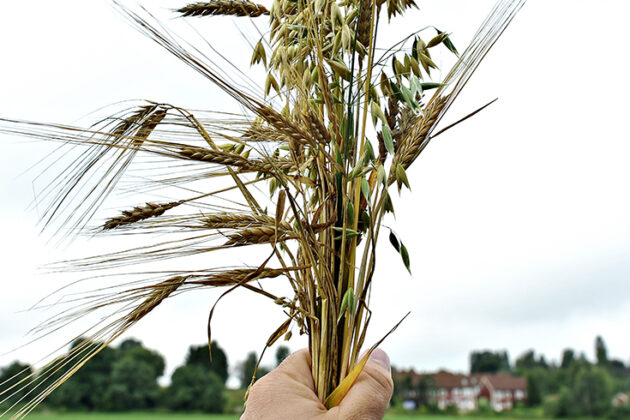The healthy ingredients of cereals

Dietary recommendations advise us to eat coarse cereal-based products every day, and choose products with a high content of dietary fibre and whole grain. There are, however, large differences between different types of fibre, and the fibres in raw materials are affected differently during processing.
Several research projects are under way at the food research institute Nofima with the objective of using the healthy components of cereals in the best possible way.
Two such projects are Optifiber and OatMet. Nofima scientists Svein Halvor Knutsen, Simon Ballance and Anne Rieder are studying two different aspects of dietary fibre, and in particular beta-glucans, in the Optifiber project. “In this project we study the effect of fiber addition on product quality, but also how food processing is affecting the fiber properties,” says Anne Rieder. The carbohydrate group at Nofima, which also comprises scientists Stefan Sahlstrøm and Ann Katrin Holtekjølen, is working intensively with barley and oats, and fractions obtained by milling. Barley and oats contain high levels of beta-glucans and the scientists at Nofima are looking at what happens to the beta-glucans during bread production. Together with baker André Løvaas they also study the impact of a higher beta-glucan content on bread quality.
“In the OatMet project we are investigating which components that make us feel full when we eat oats,” says Bente Kirkhus at Nofima. In addition to the fibre content itself, relevant components are phenolic acids and galactolipids (a type of fat).
Increased knowledge about dietary fibre
Dietary recommendations suggest that we should eat coarse cereal-based products every day, and choose products with a high content of dietary fibre and whole grain. There are, however, large differences between different types of fibre, and the fibres in raw materials are affected differently during processing. It is not certain that the fibres that are initially present remain intact and retain their special health effects after, for example, baking. This is a particular problem for beta-glucans.
If the wheat in a bread recipe is replaced by barley, the volume of the bread decreases since the crumb structure changes and becomes more compact. Many consumers will regard this as a poorer bread quality.
“We have investigated how much barley we can incorporate in bread without having to add extra gluten. Our model bread recipes show that it is possible to use up to 40% barley (of total flour) while retaining an acceptable bread volume and crumb structure. The goal is to bake an optimal barley bread, were both bread quality and beta-glucan specific health effects are as high as possible. Later, we would like to follow up with other beta-glucan enriched products such as smoothies. The focus is thereby always on retaining beta-glucan specific health effects during processing as much as possible,” says Anne Rieder.
Challenging enzymes
When bread is rising, enzymes that are naturally present in the flour start to break down the beta-glucan chains. This is a key factor since their specific health effect is reduced when the chain length is shortened. The scientists are therefore trying to inactivate these enzymes, using various forms of heat treatment. The heat treatment has a certain effect, but enzyme activity can still be present even after long heat treatment. Enzyme activity is high in sourdoughs and in bread recipes that include malt, while long rising times also lead to extended degradation.
Rieder and her colleagues Ballance and Knutsen have, in cooperation with other Scandinavian researchers, validated a method to measure beta-glucan molar mass in complex matrixes “We use this method to determine raw material quality and the impact of rising and baking on beta-glucan chain length”, says Anne Rieder.
The scientists take samples of the dough during rising and baking, and examine the molar mass of beta-glucan. In this way, they can determine how much the various processing steps affect the beta-glucan quality.
Beta glucans bind cholesterol and affect viscosity
After having found out how to retain large beta glucan molecules during bread production, the next step is to investigate how the beta-glucans act in the body. Beta glucans affect the viscosity, or the flow properties, of the food digesta in the stomach and small intestine. They also are considered to bind bile acids excreted into the small intestine. This results in a slower and incomplete re-absorption of bile acids, which in turn increases the biosynthesis of bile acids from cholesterol in the liver.
“The size, solubility and extractability (”bioavailability”) of the beta glucans determine how much they affect the viscosity and subsequently reduce cholesterol levels”, says Svein Halvor Knutsen.
The term bioavailability is usually used to describe to which extent different nutrients are absorbed in the intestine. Beta-glucans are a type of dietary fibers, which are by definition not absorbed in the small intestine. If used for beta-glucans, the term “bioavailability” describes instead to which extent the beta-glucan in a food is extractable and solubilized in the intestine. This determines how much of the beta-glucan in a food contributes to increased viscosity in the small intestine and thereby to the health effect. Scientists at Nofima use a model of the mouth, stomach and small intestine to measure how components in the food are affected by digestion. This model is also used to measure the “bioavailability” of beta-glucans in different food products. In another model, mimicking the large intestine, the scientists can study how fibre is broken down and consumed for energy by the intestinal flora.
“The breakdown of beta-glucans takes place in the large intestine, and we can use our model and several specialized advanced analytical tools to study how beta-glucan is broken down by the intestinal flora,” says Svein Halvor Knutsen.
Oats for metabolic syndrome
Oats contain several components that have the potential to influence the feeling of satiety and in this way influence our food intake. By combining these components in the correct manner, it may be possible to tailor food products that enhance satiety. There is evidence suggesting that satiety may be affected by an interplay between several factors. The processing of the food is important, as well as the contents of fibre, galactolipids and phenolic acids.
“In the OatMet project we are investigating which components make us feel full when we eat oats,” says Bente Kirkhus. Other Nofima scientists that are involved in the project are Stefan Sahlstrøm, Kjersti Aaby and Paula Varela. The scientists are studying the ability of oats to prevent metabolic syndrome, and are for this reason focussing on satiety, as well as components of oats that can regulate blood sugar levels and reduce blood pressure.
In a pilot study with healthy volunteers, the scientists noted that the participants experienced a greater feeling of satiety after eating porridge made with oatflour than porridge made with oatflakes. “We believe that this is because porridge made from oatflour has a higher viscosity through the digestive tract, since a greater fraction of the beta glucans is solubilized and hence available to increase the viscosity. Furthermore, free phenolic acids are more readily released in oatflour porridge than in oatflake porridge,” says Bente Kirkhus.
Scanning the stomach
In collaboration with scientists at Institute of Food Research (Norwich, UK), Magnetic resonance imaging will be used to investigate what happens in the stomach when humans eat portions of porridges with the same nutrient content but different food structure, i.e. oatflour and oatflakes. “The objective is to determine how fast the stomach empties, and to correlate this with the feeling of satiety and levels of satiety hormones in the blood. Since each participant will eat both types of porridges, we hope to obtain detailed information about potential differences,” concludes Bente Kirkhus.
Facts about project funding
Both Optifiber and OatMet are funded by “The Research funding for agriculture and food industry in Norway”.
Phenolic acids
Phenolic acids are a type of antioxidant that promote health and inhibit cancer. The processing methods used play a major role in determining the amount of available phenolic acids. Fermentation with lactic acid bacteria significantly increases the content of free phenolic acids.
Metabolic syndrome
Metabolic syndrome affects approximately 30% of the Norwegian population. The syndrome is characterised by abdominal obesity and at least two of the following: dyslipidemia, insulin resistance, inflammation, and high blood pressure. Metabolic syndrome itself is not a disease, but it increases the risk of major public health conditions such as cardiovascular disease and type 2 diabetes.
We do not know the causes of metabolic syndrome, but we do know that both inheritance and environment play a role. Much research remains to be done in this field, and the increase in the number of people affected by metabolic syndrome shows that we must increase our knowledge rapidly.

